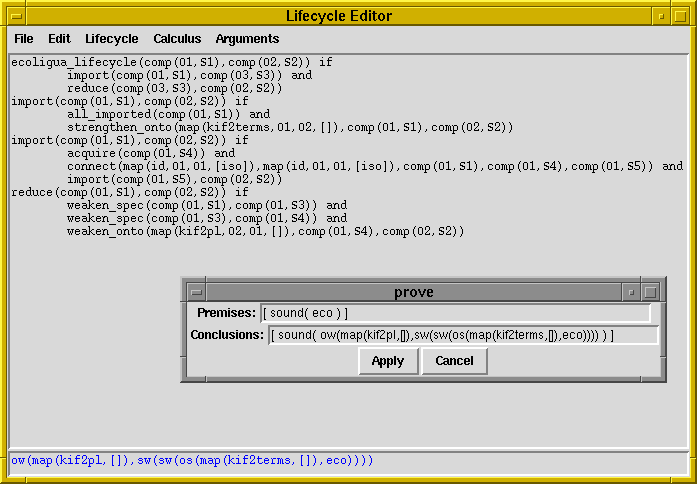  |
As we have shown with Ecolingua's life cycle, formal representations of knowledge life cycles require the rigorous analysis, representation, and (re-)execution of life-cycle patterns. But for these goals any sensible language that allows for recording knowledge transformations of life cycles would suffice. A significant gain is obtained with a formal semantics for a life-cycle language as proposed in [7], such that particular properties of knowledge components can be checked or inferred from the structure of their respective life cycles.
In our example architecture, when eventually the life-cycle execution terminates, it yields as a response a term that captures the life-cycle historyof Ecolingua in terms of our semantically-rich life-cycle calculus. This life-cycle history can then be used to prove arguments about properties of knowledge components by looking at their evolutionary paths rather than by inspecting the specification of the components themselves.
Figure 6 shows our life-cycle editor of Section 1 again (compare with Figure 5), but at the moment where the knowledge engineer is about to ask for the validity of an argument concerning the soundness of Ecolingua at different stages of its life cycle. In particular, the engineer attempts to prove if, the final knowledge component--identified by its life-cycle history displayed in the bottom part of the window--is sound, assuming that the original component before it underwent the sequence of transformations--and identified with the constant eco--is also sound. The life-cycle history displayed in the bottom part of the window corresponds to the execution of the formal life-cycle pattern as it was represented with Horn clauses, and captures the structure of Ecolingua's life cycle as illustrated in Figure 1. In this particular case, the argument we attempt to prove will be shown to be valid.
Here is a piece of reasoning that results from a semantically-rich life-cycle history that recorded the sort of transformations applied to Ecolingua. It is only practical to perform this kind of reasoning through use of life-cycle histories, and these must be supported through automated synthesis in order to deal with the scaling problem of recording and reasoning about such information in large, open systems.